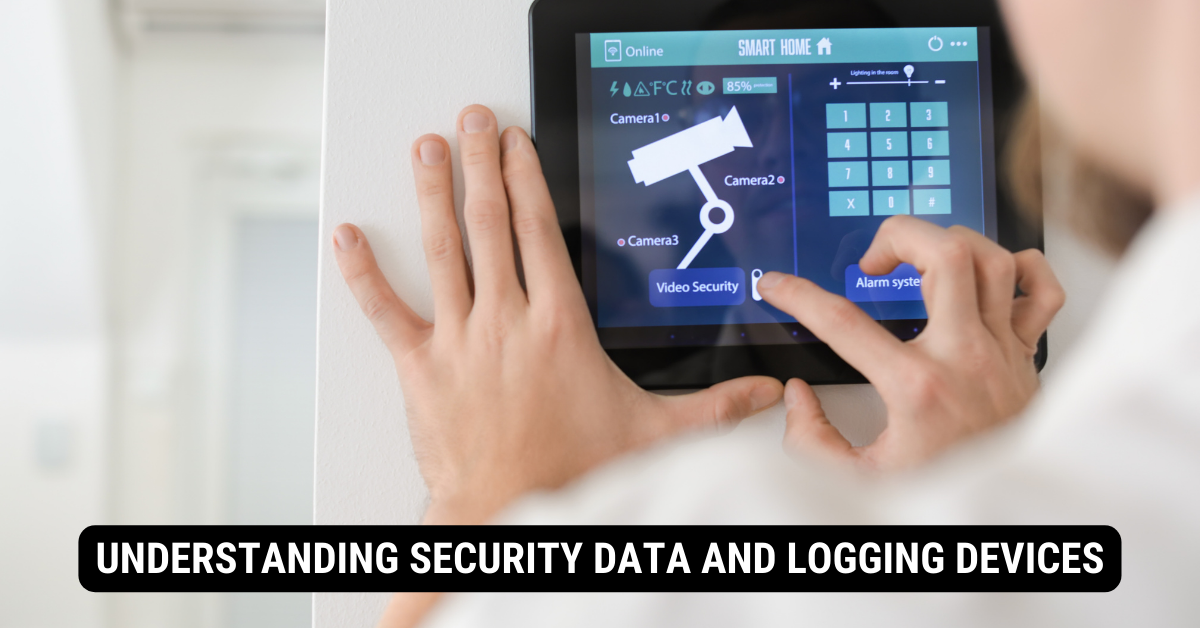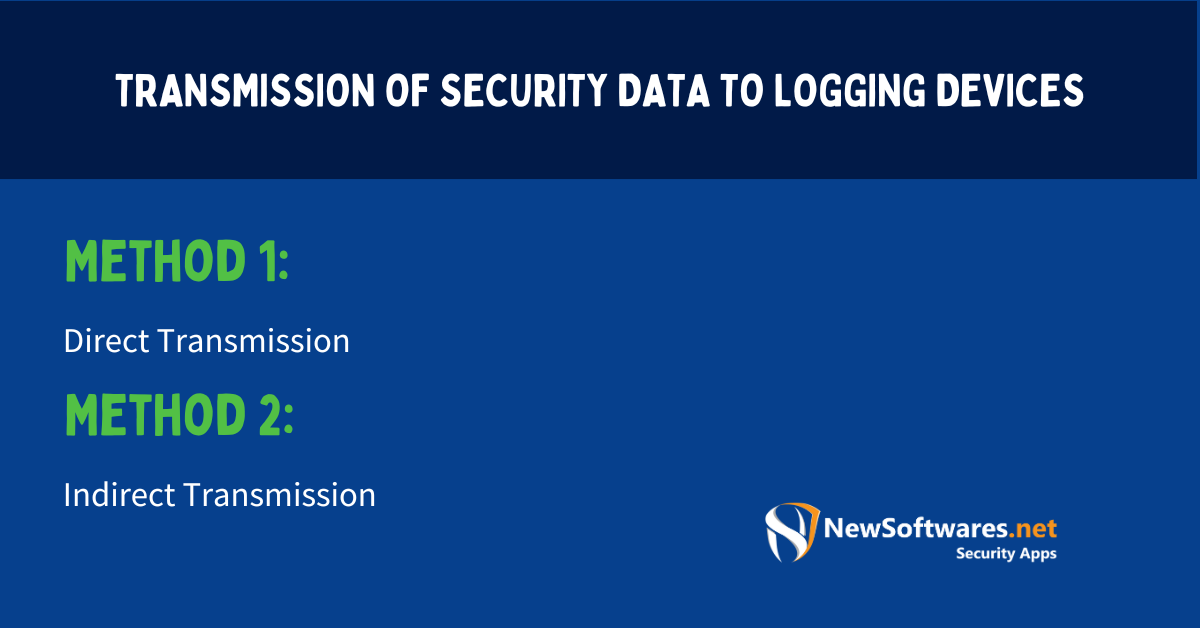A logging device typically receives various security data, including but not limited to login attempts (successful and failed), system alerts, configuration changes, firewall hits, and other suspicious activities.
In the digital era, security data protects valuable information across various platforms. When generated and transmitted strategically, this data can serve as a robust security mechanism. But what exactly is security data, and how is it dispatched to a logging device? I will explores these queries in detail.
Understanding Security Data and Logging Devices

To comprehend the significance and functionality of security data, it is crucial to understand what it entails. Security data refers to the data generated within a secured system meant to record and keep track of all the activities conducted within the system. This data is indispensable in identifying threats, improving the current security system, and ensuring the overall safety of the organizational data.
Security data plays a vital role in safeguarding sensitive information and protecting against cyber threats. It is a digital trail, documenting every action and event in a secure system. By apprehending and analyzing this data, organizations can gain valuable insights into potential vulnerabilities and take proactive measures to enhance their security measures.
The Importance of Security Data
Security data serves numerous purposes in bolstering an organization’s defenses against potential cyber threats. A dedicated security system that continually generates and examines security data is crucial to maintaining a stable and safe digital environment. It aids in identifying system vulnerabilities, detects potential cyber-attacks, and supports forensic investigations in the case of a security breach.
Furthermore, security data enables organizations to establish a baseline for normal system behavior. By monitoring and analyzing patterns in the data, any deviations or anomalies can be quickly identified, allowing for immediate action to mitigate potential risks. This proactive approach helps organizations stay ahead of cybercriminals and minimalize the impact of security incidents.
Moreover, security data can provide valuable insights into system performance and user activities and help management make informed decisions about upgrading or altering their existing security setup. By analyzing the data, organizations can identify areas where security measures may be lacking and implement appropriate improvements to ensure the integrity and confidentiality of their data.
What is a Logging Device?
A logging device, often called a log, is an integral part of any security structure. It is a tool that records events happening within a computing system. These events can be any change in system state, user actions, or system errors.
Logs function as a compilation of security data, ensuring easy and efficient analysis of system activities. They are also critical in troubleshooting, auditing, and responding to specific security incidents. Organizations can proactively respond to threats and avert potential damages by comprehensively studying log data.
Logging devices come in various forms, from software-based solutions to hardware appliances. These devices are intended to capture and store vast amounts of data related to system activities, creating a comprehensive record of events. They can capture information such as login attempts, file modifications, network connections, etc.
With the snowballing complexity and sophistication of cyber threats, logging devices have become essential to any robust security infrastructure. They provide organizations with a valuable source of information that can be used to sense, investigate, and respond to security incidents effectively.
In conclusion, security data and logging devices are crucial in maintaining a secure digital environment. By capturing and analyzing security data, organizations can identify potential vulnerabilities, detect and respond to cyber threats, and make informed decisions to enhance their overall security posture.
Types of Security Data Generated
The three main types of security data usually generated are Network, Application, and System security data. Each has its unique traits and responsibilities, contributing to the comprehensive defense strategy of an organization.
Network Security Data
Network security data refers to records of all network activities, including the traffic coming in and out of the system, abnormal behavior, and potential intrusion attempts. It’s essential for monitoring the health of a network and ensuring its integrity, confidentiality, and availability.
Network security data can provide valuable insights into the overall network performance and potential vulnerabilities. Organizations can identify patterns and trends that may indicate malicious activities or emerging threats by analyzing this data. For example, increased incoming traffic from a specific IP address might indicate a potential Distributed Denial of Service (DDoS) attack.
Furthermore, network security data can help organizations identify unauthorized access attempts and potential breaches. By monitoring network traffic logs, organizations can detect and respond to suspicious activities in real time, preventing unauthorized access to sensitive information.
Application Security Data
This type of data is concerned with the application layer of a system. Application security data includes error logs, access logs, and transaction logs. It becomes crucial when investigating a security breach or an application failure, as it can provide valuable insights and possibly lead to the source of the problem.
Application security data can help organizations identify vulnerabilities within their applications. By analyzing error logs, organizations can detect and address software bugs or coding errors that may expose the application to potential attacks. Access logs, however, can provide information about who accessed the application and when helping organizations track user activities and detect any unauthorized access attempts.
Transaction logs are particularly important for organizations that handle sensitive data or financial transactions. These logs capture information about each transaction, including the user, date, time, and transaction details. Analyzing transaction logs can help organizations identify fraudulent activities or suspicious transactions, mitigating risks and ensuring the integrity of their systems.
System Security Data
System security data, as the name suggests, is the log of all the activities happening within the system. It includes data about system changes, updates, user activities, and error messages. This data is often crucial in forensic investigations and system audits.
System security data provides organizations with a comprehensive view of their system’s health and performance. Organizations can identify vulnerabilities, track system changes, and monitor user activities by analyzing system logs. For example, if a system administrator makes unauthorized changes to the configuration, the system security data can help detect and address such actions.
In addition, system security data is valuable for forensic investigations. In a security breach or incident, system logs can provide a detailed timeline of events, helping organizations understand how the breach occurred and what actions were taken. This information is crucial for identifying the incident’s root cause and implementing appropriate security measures to prevent future occurrences.
How Security Data is Generated?
Security data can primarily be generated through user activities, system events, and network traffic. Exploring these methods in detail would provide a comprehensive understanding of the genesis of security data.
Regarding security data, user activities play a significant role in its generation. Each action performed by a user, from logging in to performing specific tasks, is recorded and stored in log files. These files serve as a treasure trove of information that can be used to monitor user behavior, identify unauthorized access attempts, and spot potential security risks.
Furthermore, security data can also be derived from system events. Every change in a system state is recorded as a system event. These events can include system start-up or shut-down, software installations, changes in system settings, and failures. Organizations gain valuable insights into overall system management and security by analyzing these events.
In addition to user activities and system events, network traffic is another rich source of security data. Data packets traveling across the network are closely monitored and recorded. This meticulous observation provides insights into data flow patterns, potential chokepoints in the network, and unusual behavior that might signify potential attacks or breaches.
Moreover, security data generated from network traffic analysis can help detect anomalies, such as sudden spikes in data volume or unexpected communication patterns, which might indicate the presence of malicious activities. By leveraging this data, organizations can strengthen their network security posture and proactively defend against potential threats.
Transmission of Security Data to Logging Devices

Once the security data is generated, its transmission to logging devices is the next vital step. This can be conducted through direct and indirect methods.
Direct Transmission Methods
Direct transmission of security data to logging devices implies that the logs are sent in real-time. The pertinent data is instantaneously dispatched to the logging device as soon as an event occurs. This method is beneficial as it provides immediate insights into the system status and swiftly detects potential risks.
The security data is typically transmitted using protocols such as TCP/IP or UDP/IP in direct transmission methods. These protocols ensure reliable and efficient data delivery to the logging devices. The data is often encrypted to maintain its confidentiality and integrity during transmission.
Furthermore, direct transmission methods often involve dedicated communication channels between the systems generating the security data and the logging devices. These channels are designed to handle the high volume of data generated by security events, ensuring that no data is lost or delayed during transmission.
Syslog is a common direct transmission method, a standard protocol for sending log messages over IP networks. Syslog allows for the centralization of logs from multiple sources, making it easier to manage and analyze security data from different systems.
Indirect Transmission Methods
Indirect transmission methods, on the other hand, involve storing the data temporarily before it is transferred to the logging device. This might be preferred in cases where immediate transmission isn’t crucial or feasible due to network bandwidth limitations.
The security data is first collected and stored in a local buffer or cache in indirect transmission methods. This buffer is temporarily stored until the data can be transferred to the logging device. The data can be stored in various formats, such as flat files or databases, depending on the requirements of the logging system.
Once the data is stored in the local buffer, it can be transferred to the logging device using different mechanisms. One common approach is to use scheduled transfers, where the data is periodically sent to the logging device at predefined intervals. This allows for more efficient use of network resources and reduces the impact on system performance.
Another method used in indirect transmission is the use of data aggregation tools. These tools collect and consolidate the security data from multiple sources before transferring it to the logging device. This approach helps reduce network traffic and optimize the logging system’s storage capacity.
Indirect transmission methods also allow additional data processing and filtering steps before the data is sent to the logging device. This allows for data customization based on specific requirements, such as removing sensitive information or enriching the data with additional contextual details.
Overall, both direct and indirect transmission methods play a crucial role in ensuring the timely and efficient delivery of security data to logging devices. The choice of method depends on factors such as the urgency of data transmission, network capabilities, and the specific requirements of the logging system.
Analyzing and Interpreting Security Data
Analysis of the gathered security data is a critical aspect of streamlining one’s security strategy. Organizations can bolster their defenses and ensure secure operations by understanding log files and identifying potential security threats.
Understanding Log Files
Log files are the building blocks of security data. A keen understanding of these files and their components is required to interpret the generated security data effectively. Log files usually consist of date and time stamps, event messages, error codes, user IDs, source IPs, and similar information, which can speak volumes about the system’s performance and security standing.
Identifying Potential Security Threats

Security data can reveal threats and vulnerabilities before they translate into substantial harm. By identifying malicious patterns, abnormal behavior, and security inconsistencies in the data, potential threats can be mitigated beforehand, securing the system, the data it holds, and the entire organization.
Overall, comprehensive knowledge of security data generation and its transfer to logging devices can significantly enrich a business’s cyber defense mechanism, ensuring the safe and smooth execution of digital operations.
Key Takeaways
- Log data provides insights into system activities and potential threats.
- It tracks both ordinary and strange system behaviors.
- Logging is crucial for post-incident investigations and compliance purposes.
- The type of logged data varies based on system configurations and organizational policies.
- Log management and periodic reviews are crucial for effective security monitoring.
FAQs
Q: Why is logging important in cybersecurity?
A: It helps monitor system activities, detect anomalies, and aids post-incident analysis.
Q: How often should logs be reviewed?
A: While automated systems monitor logs continuously, manual reviews should occur regularly, depending on the system’s criticality.
Q: Can logs be tampered with?
A: Without proper security, logs can be tampered with, so it’s essential to have integrity checks and restricted access.
Q: How long should logs be retained?
A: Retention depends on organizational policies, regulatory requirements, and storage capabilities.
Q: Do all devices send the same type of log data?
A: No, the log data varies based on the device’s function, configuration, and the software it runs.
Conclusion
In the digital age, security data and logging devices are vital. Security data, which tracks user actions, system events, and network traffic, offers deep insights into system vulnerabilities and threats. Acting as a digital record, it helps organizations monitor and address potential cyber risks. Logging devices store these events, facilitating analysis and issue resolution. This data can be transmitted to logs directly or stored temporarily before transfer. Analyzing these logs is key for improving cybersecurity, and regular log reviews are essential for thorough security oversight.
